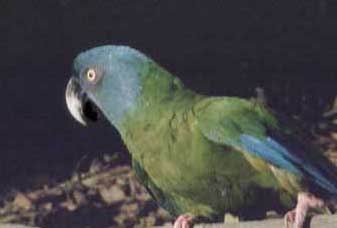Macaw - Blue Headed
Scientific Name: Ara severa castaneifrons
Sat, 12th July, 2025 - 3:53 am GMT
Sponsor Ads:

Alternative Name
Scientific Name: Ara severa castaneifronsBasic Info
The Blue-Headed Macaw is truly a beautiful species of Macaw. They are green overall, about two feet in total length. They have aqua colored cheek feathers and blue highlights beneath. Their tails are a deep, rich red color, the under part of the tail sporting yellow and green feathers. Immature individuals can be distinguished from adults by their darker irises.
Health
Lafresnaye Macaws do well when fed on a variety of foods including; fruits, vegetables, and commercial pellets. White bread and biscuits are the perfect food to hand rear young Lafresnaye Macaws. Pasta, beans, pine nuts, and porridge all make fine treats for Lafresnaye Macaws. They also need fresh water at all times, and love bathing! Because of their smaller size, Lafresnaye Macaws will do well in an outdoor nine by three by six food enclosure with an enclosed shelter. Lafresnaye Macaws do best if kept in pairs within hearing distance of each other. They are quite noisy and need lots of attention to prevent loneliness and depression. They are sturdy after acclimatization but should not be kept below 41 degrees Fahrenheit. Breeding In captivity, Lafresnaye Macaws are quite prolific if paired correctly. The breeding season usually begins in May, when Lafresnaye Macaws may become aggressive, attacking similar sized birds or their handler. Give your birds a diagonally oriented nesting box with a twelve-inch entry hole and 10 by 14 by 16-inch dimensions. These Macaws usually have clutches consisting of about four eggs that hatch in 26 days. Generally, not all the eggs will be fertile. The fledgling period lasts about twelve weeks and young Lafresnaye Macaws are quite independent two weeks after leaving their parents.Habitat
These striking parrots are most commonly seen in forested areas.Behavior
The Blue Headed Macaw is considered by many to be one of the most beautiful species of Macaw in the world. The Blue-Headed Macaw is not widely kept as a pet because it is extremely rare. It is on the CITES list as endangered. Blue-Headed Macaws live in Central America, near Peru and Bolivia. Not a whole lot is known about their habits in the wild. They tend live in small groups of two or three. In the wild they are usually only seen in flight. Their dietary preferences in the wild are largely unknown. In captivity they are known to do well on normal captive macaw diets. Like many other species of Macaw, the Blue Headed Macaw loves to chew, and particularly enjoys chewing branches. They are said to be relatively easy to tame in captivity and are relatively hardy.Origin
South AmericaHistory
The Blue Headed Macaw is native to South America. It is most commonly seen in Northern Bolivia, Eastern Peru and Western Brazil. They are fairly adaptable and have been seen in populated areas as well. They are also known to have done quite well in cleared forest areas.Common Foods
N/ASponsor Ads:
"I do not feel obliged to believe that same God who endowed us with sense, reason, and intellect, had intended for us to forgo their use." -- Galileo
Macaw - Blue Headed
Coded by: BGID® | ALL RIGHTS RESERVED Copyright © 2000-2025
Disclaimer | Privacy | Report Errors / Contact | Credits


 Preparing For China. China is growing their military. China Military Technology - can it keep up with the US?
Preparing For China. China is growing their military. China Military Technology - can it keep up with the US?  versus
versus 

 versus
versus 
 This Thread is about the North Korean Military itself - the kind of army, navy, and air force they have.
This Thread is about the North Korean Military itself - the kind of army, navy, and air force they have. 
 versus
versus 
 versus
versus  versus
versus